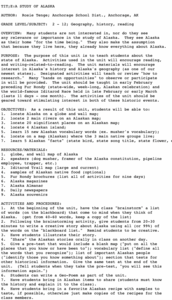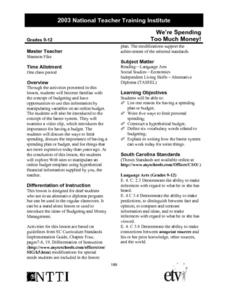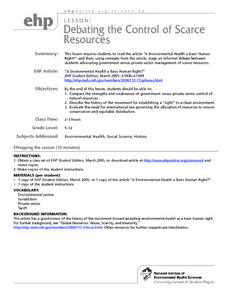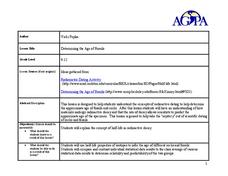Advocates for Human Rights
The Right to Workers in United States
To raise awareness and understanding of modern-day slavery, class groups research the various forms of slavery, including human trafficking, read and reflect on case studies, and design a plan of action for their community.
PBS
Stories of Painkiller Addiction: Contemplating Nature vs. Nurture
Does having an addict in your family make it more likely to become one yourself? Explore the genetic risk factors, as well as the prominent environmental influences, for substance addiction in a lesson that encourages awareness and open...
Cornell University
Beam Focusing Using Lenses
Explore optics using an inquiry-based experimental approach! Young scholars use a set of materials to design and build a unit capable of focusing a beam of light. They experiment with different lenses to determine the best approach to...
Curated OER
Art and Careers
Students study and inquire what museum curators do and their responsibilities of collecting, displaying, researching, maintaining, and promoting their collections. They research an art museum and choose one work of art that is their...
Curated OER
Play Ball: A Major League Review Game
Apply the game of baseball to a fun review activity. Pupils earn a "base" for each subject question that they answer correctly. This activity can be modified and used for any subject area, including math, social studies, and language arts.
Cornell University
Thin Films
Combine mathematics and science to calculate measurements of unmeasurable materials. Individuals use knowledge of density and volume to determine the thickness of the film used in production. They also apply stoichiometry to determine...
Curated OER
Stereotypes and Cross-Cultural Understanding
Students are introduced to the topic of stereotypes. After reading an article, they complete a chart filling out the appropriate sections. They participate in a class discussion about how to eliminate as many stereotypes as they are...
Curated OER
Symbols from History: Mesopotamia Today
Students identify the various symbols different nations use to represent themselves. As a class, they discuss the recent events in Iraq and identify the needs of its people. They use print resources to research various Mesopotamian...
Curated OER
Word Roots 2: Fin, Sed, Fer Intermediate Puzzle 1, 2, & 3
If you are interested in practicing Latin word roots in your class, consider this resource. Focusing particularly on the roots fin, sed, and fer, these brief fill-in-the-blank activities provide a word bank for reference. Learners look...
Curated OER
Modernism in Poetry, Painting, and Music
Are you teaching Modernism to your class? Connect different areas of artistic expression in the Modernist Era. Learners read T.S. Eliot, view art by Pablo Picasso, and listen to a Modernist musical composition. This final assignment is...
Curated OER
A Study of Alaska
Pupils explore Alaska. This lesson is gearing mostly for students who live in Alaska.
Curated OER
Wild Dog Debate
Learners participate in a mock conference addressing the possible extinction of African wild dogs. In this wild dogs lesson plan, students state their arguments and ask questions about the issues they have researched.
Curated OER
Reader's Theater: Presenting Asian Folktales
Learners create and perform folktale plays. In this reader's theater and Asian literature lesson, students work in groups to rewrite Asian folktales into scripts and perform the folktales for their class in a Reader's Theater. Lesson...
Curated OER
World of Plastics and Polymers
Students investigate plastics and learn they are giant molecules made of carbon atoms. In this polymers and plastics lesson, students perform 3 activities which all include making polymers from household items such as milk and vinegar,...
Curated OER
We're Spending Too Much Money
Students discuss the reasons for having a budget. They create their own personal budget and explain how the bartering system can work for some items today.
Curated OER
It's The States of Matter
Students investigate the properties of solids, liquids and gases. In this states of matter lesson plan, students observe dry ice and its characteristics. They calculate the density of dry ice and observe the sublimation of the dry ice...
Curated OER
Novel Evaluation Presentations
Students summarize and make predictions about the novel, "Huckleberry Finn". They discuss their opinions with the class. They give a one-minute novel evaluation about another novel and choose a novel based on their classmate's...
Curated OER
Debating the Control of Scarce Resources
Students examine the issue of government versus private sector control of natural resources. They read an article, evaluate the need for international law governing resource allocation, and participate in a class debate.
Curated OER
Lights in the Deep
Students describe, compare, and contrast bioluminescence, fluorescence, phosphorescence, and chemiluminescence. They explain the role of three major components of bioluminescent systems. They ex
Curated OER
Search for Ice and Snow
Students use satellite images to locate areas of ice and snow on the globe. They create a table showing the information they gathered. They present their information to the class.
Curated OER
Exploring Restoration Techniques
Students, after taking a field trip to a museum, use paint to try to restore old objects.
Curated OER
The Life of Dona Felisa Rincon De Gautier
Young scholars identify Puerto Rico and discuss its relationship and proximity to the United States. Next, students identify significant events that occurred during Dona Felisa's term in office and how if may have affected her...
Curated OER
Earth Science - Earth's Atmosphere
Students build an understanding of the dynamics and composition of the atmosphere and its local and global processes influencing climate and air quality. They analyze global atmospheric changes including changes in CO2, CH4, and...
Curated OER
Determining the Age of Fossils
Students examine the concept of radioactive dating. In this radioactive dating lesson plan, students investigate how to determine the ages of fossils and rocks as they learn about half-life radioactive decay.

























